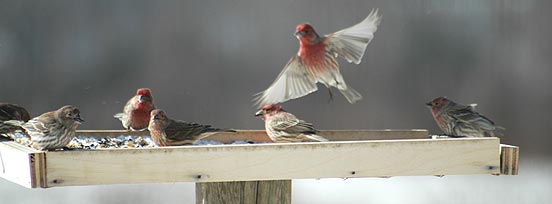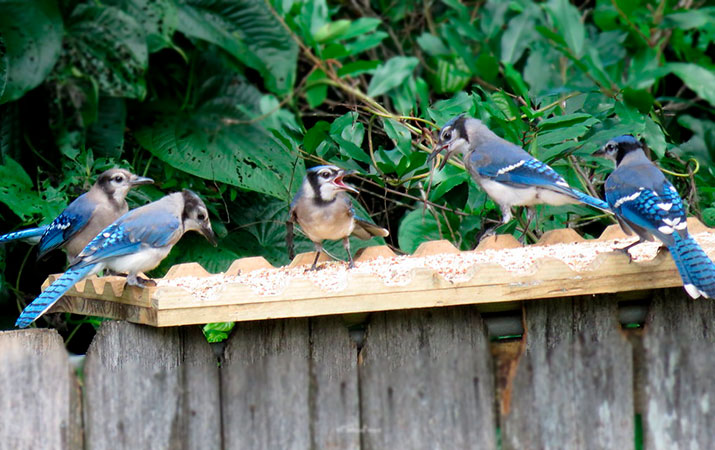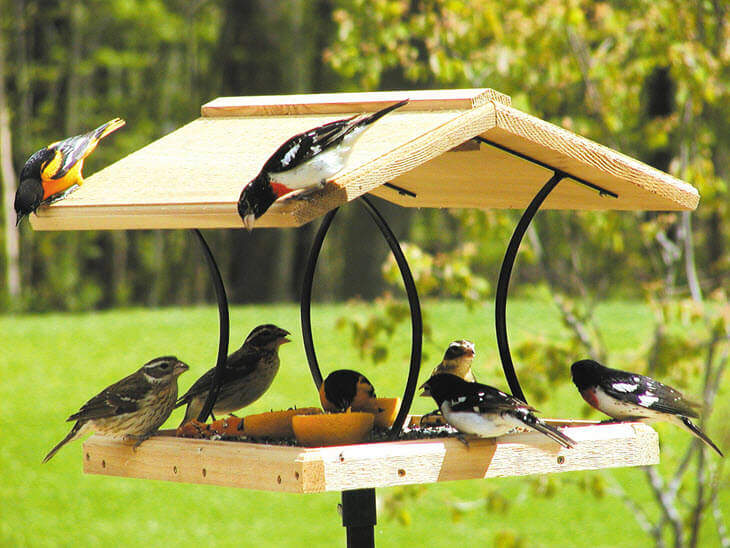A platform bird feeder is the most straightforward and adaptable of all bird feeders. It has a square or rectangular base with side pieces to prevent birdseed spillage. A tray feeder is referred to as an inclusive feeder. In contrast to tube and hopper feeders, a tray feeder is a simple platform without feeding ports or shapes that may frighten timid species or require birds to figure out how to access the seed. A tray feeder is ideal for individuals just beginning to feed birds at home. It is simple to refill and can be placed anywhere, including on the ground.
This article describes tray or platform bird feeders, their types, how they function, and the benefits and drawbacks of owning one.

How Does a Tray or Platform Bird Feeder Function?
A tray feeder is the most basic type of bird feeder. It has a square or rectangular base with sides at the edges to prevent spillage. The tray is directly filled with birdseed, visible to the birds.
Bird feeders with trays are the least exclusive. Other bird feeders have shapes and feeding ports of varying sizes, requiring the birds to figure out how to access the food and permitting only specific bird sizes and bill shapes. A tray or platform resembles an open space on the ground, which birds, particularly ground-feeding birds, are accustomed to feeding regularly.
Is a Platform Bird Feeder the Best Option for a Beginner?
Consistently sprinkling birdseed on the ground can suffice to feed birds. Birds will find the seed that has been put out for them, and if they feel it is safe, they will return.
The second simple method of feeding birds is to use the tray of a platform bird feeder. This feeder has the most uncomplicated design, is simple to refill, and attracts a wide variety of birds, including those that feed on the ground and in the trees.For tray feeders that lack protection from rain and snow, offering a quantity of birdseed that can be consumed within one or two days is recommended. Molds can develop on wet bird seeds, which can harm the birds.
Some platform feeders have a plastic or metal mesh bottom tray that prevents water from collecting and rotting the bird seed.
Different Types of Tray/Platform Bird Feeders
There are numerous trays or platform bird feeders, all of which employ the same concept of a baseboard or base screen with sides to prevent spillage.
Some tray feeders are made of plastic or a combination of wood and other substances. Some products contain recycled plastic.
Feeder prices vary based on size, design, and construction materials.
Some tray feeders have a wire netting or plastic screen bottom to prevent water accumulation and filter residues.
Others have wire netting on top, preventing squirrels from eating the birdseed while allowing birds access to the seeds.
How Long Will it be Before Birds Discover Platform Feeders?
It may take birds a few days to several months to locate a bird feeder. Indeed, the type of feeder can have an impact.
The contents of a tray feeder are exposed and readily visible to the birds, in contrast to the contents of other bird feeders, where they are concealed.
However, additional factors contribute to a tray feeder being readily discovered by birds.
The time it takes for birds to locate a feeder also depends on the surrounding habitat.
Due to the greater bird diversity that inhabits woodland habitats, feeders in yards surrounded by woods have a greater chance of being visited.
It is more likely that numerous species of birds will find a feeder and the food offered to them.
In contrast, feeders placed in treeless neighborhoods attract fewer species of birds and take longer for birds to locate.
Visitors to feeders find their food visually. If the feeder is well-exposed and visible, birds will almost always find it faster.
Once a single bird discovers the feeder, additional birds of the same species will likely begin visiting.
Multiple species of birds will make your feeder a daily stop in their quest for food over time.
What are the Benefits and Drawbacks of Platform Bird Feeders?
Tray/platform bird feeders have both advantages and disadvantages.
Benefits
Tray feeders are used for non-exclusive feeders. Unlike other bird feeders, its design and food presentation do not restrict birds of specific sizes and beak shapes.
They can be installed on existing structures, windows, poles, the ground, or nearby.
Platform/tray feeders can accommodate any type of bird food, including birdseed, fruit, peanuts in the shell, mealworms, and any other item one might wish to offer birds.
Easy to clean and maintain. Some individuals invert the feeder and shake off any leftover food, while others hose down and scrub food that has adhered to the feeder.
Simple to make.
Drawbacks
Most tray feeders lack a cover and have a plywood bottom board. Rain and snow will likely saturate bird food, potentially harming fungal growth. Some tray feeders have a screen bottom that aids in water drainage and a cover that prevents rain or snow from falling into the tray.
Birds perch and move on the feeder, leaving behind droppings that contaminate both the food and the feeder. Mixing bird droppings with birdseed could aid in the spread of disease among birds.
Birds and squirrels have easy access to tray feeders, and chipmunks also benefit. Unless a baffle is attached to the pole holding the platform feeder, squirrels and chipmunks may cause severe damage.
The Best Location to Mount a Platform Bird Feeder

A platform feeder can be placed wherever the user desires. You are capable of being creative. Nevertheless, there are a few factors to consider.
- Protect the birds from domestic cats and hawks.
- People who have fed birds for years recommend mounting platform bird feeders and all other bird feeders at least 16 feet away from trees and bushes.
- The width of sixteen feet is sufficient for birds to see their surroundings and react to an approaching hawk's attack.
- Additionally, sixteen feet in width prevents domestic cats from hiding and attacking the birds.
- Although sixteen feet from trees and bushes are ideal for protecting birds, shy species such as buntings and wrens are reluctant to venture out into the open. These birds do well in feeders placed much closer to bushes, but cats must not be a problem.
- It must be positioned on bare ground or short-mown grass to prevent cats from hiding near the feeder.
- From the ground, tray feeders can be installed at any height. Some individuals position a tray feeder beneath a hanging tube or hopper feeder. In this case, the feeder's purpose is to collect the seeds dropped by other birds so that they are still accessible to birds that prefer to feed on or near the ground.
Conclusion
A tray feeder is one of the most popular types of bird feeders. The operation of these feeders is straightforward. On an open platform, birdseed is poured for the birds to consume. Regarding bird preference, tray bird feeders attract a greater variety of birds than other feeders.
A feeder is accessible to birds of all sizes and beak shapes due to its straightforward design. Tray or platform feeders are an excellent option for beginning bird watchers. They are a type of non-exclusive feeder. When appropriately positioned in your yard, a platform feeder lets you observe birds from the comfort of your home.


